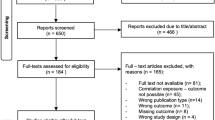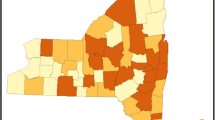Abstract
Objective
We explored age-specific and gender-specific effects of fluoride level in drinking water and the incidence of osteosarcoma.
Methods
We used data from a matched case–control study conducted through 11 hospitals in the United States that included a complete residential history for each patient and type of drinking water (public, private well, bottled) used at each address. Our analysis was limited to cases less than 20 years old. We standardized fluoride exposure estimates based on CDC-recommended target levels that take climate into account. We categorized exposure into three groups (<30%, 30–99%, >99% of target) and used conditional logistic regression to estimate odds ratios.
Results
Analysis is based on 103 cases under the age of 20 and 215 matched controls. For males, the unadjusted odds ratios for higher exposures were greater than 1.0 at each exposure age, reaching a peak of 4.07 (95% CI 1.43, 11.56) at age 7 years for the highest exposure. Adjusting for potential confounders produced similar results with an adjusted odds ratio for males of 5.46 (95% CI 1.50, 19.90) at age 7 years. This association was not apparent among females.
Conclusions
Our exploratory analysis found an association between fluoride exposure in drinking water during childhood and the incidence of osteosarcoma among males but not consistently among females. Further research is required to confirm or refute this observation.



Similar content being viewed by others
References
Link MP, Eilber F (1997) Osteosarcoma. In: Pizzo PA, Poplack DG (eds) Principles and practice of oediatric oncology, 3rd edn. Lippincott-Raven Co., Philadelphia, pp 889–920
Dorfman HD, Czerniak B (1995) Bone cancers. Cancer 75(Supplement):203–210
Homa DM, Sowers MFR, Schwartz AG (1991) Incidence and survival rates of children and young adults with osteogenic sarcoma. Cancer 67:2219–2223
Miller RW, Boice JD Jr, Curtis RE (1996) Bone cancer. In: Schottenfeld D, Fraumeni JF Jr (eds) Cancer epidemiology and prevention. Oxford University Press, New York, pp 971–983
Fraumeni JF Jr (1975) Bone cancer: epidemiologic and etiologic considerations. Front Radiat Ther Oncol 10:17–27
Miller RW (1981) Contrasting epidemiology of childhood osteosarcoma, Ewing’s tumor, and rhabdomyosarcoma. Natl Cancer Inst Monogr 56:9–14
Tucker MA, D’Angio GJ, Boice JD Jr et al. (1987) Bone sarcomas linked to radiotherapy and chemotherapy in children. N Engl J Med 317:588–593
Finkelstein MM, Kreiger N (1996) Radium in drinking water and risk of bone cancer in Ontario youths: a second study and combined analysis. Occup Environ Med 53:305–311
Price CHG (1958) Primary bone-forming tumors and their relationship to skeletal growth. J Bone Joint Surg 40B:574–593
Fraumeni JF Jr (1967) Stature and malignant tumors of bone in childhood and adolescence. Cancer 20:967–973
Gelberg KH, Fitzgerald EF, Hwang S, Dubrow R (1997) Growth and development and other risk factors for osteosarcoma in children and young adults. Int J Epidemiol 26:272–278
Gruber HE, Baylink DJ (1991) The effects of fluoride on bone. Clin Orthop 267:264–277
Whitford GM (1996) The metabolism and toxicity of fluoride, 2nd edn. Basil, Karger, pp 1–5, 89–90, 94
Bucher JR, Hejtmancik MR, Toft II JD, Persing RL, Eustis SL, Haseman JK (1991) Results and conclusions of the National Toxicology Program’s Rodent Carcinogenicity Studies with sodium fluoride. Int J Cancer 48:733–737
Hrudey SE, Soskolne CL, Berkel J, Fincham S (1990) Drinking water fluoridation and osteosarcoma. Can J Public Health 81:415–416
Mahoney MC, Nasca PC, Burnett WS, Melius JM (1991) Bone cancer incidence rates in New York State: time trends and fluoridated drinking water. Am J Public Health 81:475–479
Freni SC, Gaylor DW (1992) International trends in the incidence of bone cancer are not related to drinking water fluoridation. Cancer 70:611–618
Operskalski EA, Preston-Martin S, Henderson BE, Visscher BR (1987) A case–control study of osteosarcoma in young persons. Am J Epidemiol 126:118–126
McGuire SM, Vanable ED, McGuire MH, Buckwalter JA, Douglass CW (1991) Is there a link between fluoridated water and osteosarcoma? J Am Dent Assoc 122:39–45
Moss ME, Kanarek MS, Anderson HA, Hanrahan LP, Remington PL (1995) Osteosarcoma, seasonality, and environmental factors in Wisconsin, 1979–1989. Arch Environ Health 50:235–241
Gelberg KH, Fitzgerald EF, Hwang S, Dubrow R (1995) Fluoride exposure and childhood osteosarcoma: a case–control study. Am J Public Health 85:1678–1683
Hoover RN, Devesa S, Cantor K, Fraumeni JF Jr (1991) Time trends for bone and joint cancers and osteosarcomas in the Surveillance, Epidemiology and End Results (SEER) Program. In: Review of fluoride benefits and risks. U.S. Department of Health and Human Services, Washington, DC (Appendix F)
Cohn PD (1992) An epidemiologic report on drinking water and fluoridation. New Jersey Department of Environment Protection and Energy and the New Jersey Department of Health, Trenton
McGuire S, Douglass CW, Joshi A, Hunter D, DaSilva J (1995) Fluoride exposure and osteosarcoma. J Dent Res 74(AADR Abstracts):98
U.S. Department of Health and Human Services (1988) Fluoridation census, 1985. Department of Health & Human Services, Public Health Service, Centers for Disease Control and Prevention, Atlanta
U.S. Department of Health and Human Services (1993) Fluoridation census, 1992. Department of Health & Human Services, Public Health Service, Centers for Disease Control and Prevention, Atlanta
Bassin EB, Mittleman MA, Wypij D, Joshipura K, Douglass CW (2004) Problems in exposure assessment of fluoride in drinking water. J Public Health Dent 64:45–49
Bassin EB (2001) Association between fluoride in drinking water during growth and development and the incidence of osteosarcoma for children and adolescents. Thesis, Harvard School of Dental Medicine, Boston, pp 54–67
Reeves TG (1993) Water fluoridation: a manual for water plant operators. U.S. Department of Health and Human Services, Centers for Disease Control and Prevention, Division of Oral Health, Atlanta, pp 20–21
Bogin B (1998) Growth cyclicities and pulsatilities. In: Ulijaszek SJ, Johnston FE, Preece MA (eds) The Cambridge encyclopedia of human growth and development. Cambridge University Press, Cambridge, pp 220–221, 226
Molinari L, Largo RH, Prader A (1980) Analysis of the growth spurt at age seven (mid-growth spurt). Helv Paediatr Acta 35:325–334
Tanner JM, Cameron N (1980) Investigation of the mid-growth spurt in height, weight and limb circumferences in single-year velocity data from the London 1966–67 growth survey. Ann Hum Biol 7:565–577
Berkey CS, Reed RB, Valadian I (1983) Midgrowth spurt in height of Boston children. Ann Hum Biol 10:25–30
Reeves TG (1996) Status and strategic plans for fluoridation: Centers for Disease Control and preventive perspective. J Public Health Dent 56:242–245
Birkett NJ (1992) Effect of nondifferential misclassification on estimates of odds ratios with multiple levels of exposure. Am J Epidemiol 136:356–362
MacMahon B, Trichopoulous D (1996) Epidemiology principles and methods, 2nd edn. Little, Brown and Company, Boston, pp 133–136
Rothman KJ (1981) Induction and latent periods. Am J Epidemiol 114:253–259
Kleerekoper M (1996) Fluoride and the skeleton. In: Bilezikian JP, Raisz LG, Rodan GA (eds) Principles of bone biology. Academic, San Diego, pp 1053–1062
WHO (1984) Fluorine and fluorides. World Health Organization, Geneva (Environmental Health Criteria 36)
Vaughan J (1981) The Physiology of bone, 3rd edn. Clarendon Press, Oxford, pp 19–20
Soames RW, section ed. (1995) Skeletal system. In: Williams PL (ed) Gray’s anatomy, 38th edn. Churchill Livingstone, New York, pp 425–736
Ershow AG, Cantor KP (1989) Total water and tapwater intake in the united states: population-based estimates of quantities and sources. Life Sciences Research Office, Federation of American Societies for Experimental Biology, Bethesda, pp 21–24
Harris NO, Clark DC (1995) Water fluoridation. In: Harris NO, Christen AG (eds) Primary preventive dentistry, 4th edn. Appleton and Lange, Norwalk, pp 159–161
Acknowledgements
The authors acknowledge Manuela Orjuela, MD, ScM, for her contributions on a preliminary analysis. This work was supported by the National Institutes of Health Grant number 5-R01 ES06000. Dr Bassin was supported by National Research Service Award grant T32 DE07151-13.
Author information
Authors and Affiliations
Rights and permissions
About this article
Cite this article
Bassin, E.B., Wypij, D., Davis, R.B. et al. Age-specific Fluoride Exposure in Drinking Water and Osteosarcoma (United States). Cancer Causes Control 17, 421–428 (2006). https://doi.org/10.1007/s10552-005-0500-6
Received:
Accepted:
Issue Date:
DOI: https://doi.org/10.1007/s10552-005-0500-6




